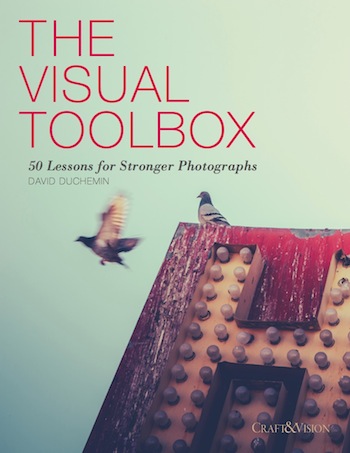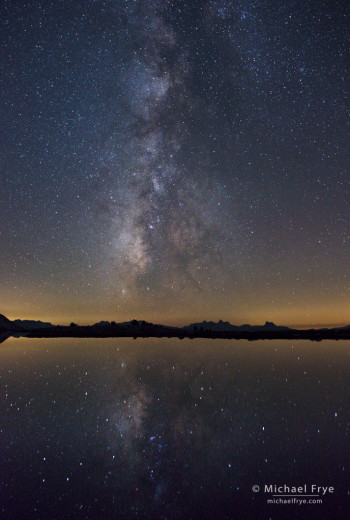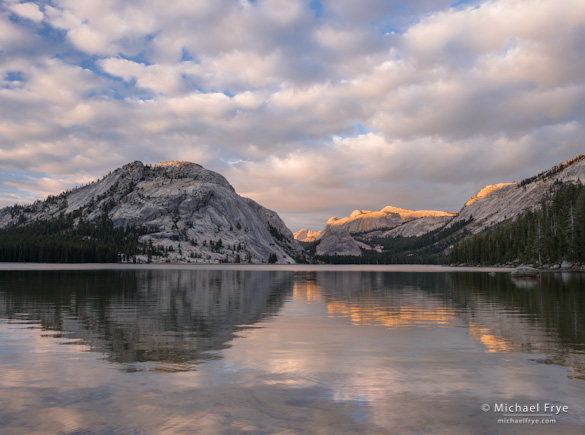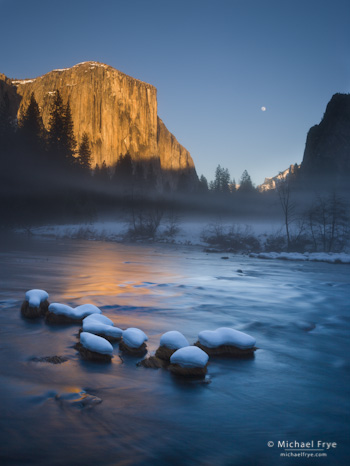In the Moment:
Michael Frye's Landscape Photography Blog
by Michael Frye | Sep 12, 2013 | Reviews
 The Visual Toolbox: 50 Lessons for Stronger Photographs
The Visual Toolbox: 50 Lessons for Stronger Photographs
by David duChemin
Craft & Vision; 201 page PDF ebook
Craft & Vision has just released their second “Big Book.” This one is called The Visual Toolbox, by C&V founder and publisher David duChemin.
I’ve said before that I think David is an excellent writer and photography educator. But this time he’s outdone himself; The Visual Toolbox is one of the best photography-instruction books I’ve ever read.
It really is a toolbox, covering almost every aspect of photography, including exposure, depth of field, composition, balance, light, how to slow down and really see, and much more. But what sets this book apart is David’s ability to offer fresh perspectives and ideas on familiar photography topics, and get you to think about these subjects in new ways.
(more…)
by Michael Frye | Aug 16, 2013 | Reviews

Milky Way reflected in an alpine lake, Yosemite NP, CA, USA. Nikon D800E with 24mm f/1.4 lens; 20 seconds, f/2.8, 6400 ISO
Regular readers of this blog know that I don’t often write about equipment. Equipment is necessary, and important, but not the most important thing in photography.
However, equipment does matter in some situations, like when trying to capture fast-moving subjects, or the faint light of stars, or when you want to make a large print that’s sharp and noise-free.
My regular camera is ancient by the fast-moving standards of the digital age. It’s a 16-megapixel Canon 1Ds Mark II, first introduced in 2004. I haven’t felt a compelling urge to upgrade. Newer models like the Canon 5D Mark II and Mark III have a little higher resolution (21 and 22 megapixels, respectively), but the difference isn’t that significant. They also handle noise better, but again, the advantages are relatively small.
One of the reasons I’ve been slow to upgrade to a new model is because while Canon has been making these modest improvements in image quality, Nikon has been making big leaps. For several years the Nikon sensors (some of which are made by Sony) have outclassed Canon in handling noise – something I could see clearly when looking at student’s photos during workshops. And last year’s introduction of the 36-megapixel Nikon D800 and D800E set a new standard for resolution in a 35mm-style DSLR. All this makes me think about switching, and hesitant to invest in more Canon equipment.
(more…)
by Michael Frye | Aug 29, 2012 | Composition, Photography Tips, Vision and Creativity

(A) Clouds and reflections, Tenaya Lake, Yosemite
At Tenaya Lake last week my workshop student and I watched and photographed a spectacular, constantly-changing cloud display for over two hours. I made many images, including the one at the top of this post (you can see two more here and here). With the lake in the foreground every composition included a prominent horizon line, so I was often thinking about where to place the horizon in the frame.
It’s not always an easy decision. If you’ve ever read any books on composition you probably learned about the rule of thirds. And when applied to horizons this means you should place the horizon a third of the way from the top or bottom of the photograph. And you probably also read that you should, at all costs, avoid putting the horizon in the center of the frame.
As many of you already know, I’m not a big fan of the rule of thirds. It’s too restrictive, too limiting when applied to the infinite number of possible subjects and situations a photographer can encounter. It’s useful sometimes, but shouldn’t be taken as dogma.
I think this applies to horizons as well. Sometimes putting the horizon a third of the way from the top or bottom works. Sometimes it’s better to ignore the rule and put the horizon right in the middle, or near the top or bottom of the frame.
(more…)
by Michael Frye | Aug 16, 2012 | Vision and Creativity

Reeds and Cloud Reflections no. 1
Planning
The future is uncertain, so we try to control it by planning. We think that if we do A and B the result will be C. But sometimes there are too many variables that we can’t account for, so the result might not be C—it could be D, or E, or even Z.
Photographers often try to plan. We imagine that if we go to a certain location at a certain time we’ll capture a certain photograph. Sometimes this works, but frequently the weather doesn’t cooperate or conditions aren’t right.
(more…)
by Michael Frye | Aug 15, 2012 | Announcements, Workshops

A January moonrise from Valley View, Yosemite
The Ansel Adams Gallery recently announced their 2013 workshops. I’m pleased to be teaching four Yosemite photography workshops for the Gallery next year—Landscapes in the Digital Darkroom: Mastering Lightroom (January); Spring Yosemite Digital Camera Workshop (April); Hidden Yosemite (July); and The Digital Landscape: Autumn in Yosemite (October).
As many of you know, I’m a big fan of Lightroom because it’s simple, yet powerful—easy to use, but sophisticated enough to get great results with almost any image. Last January was the first time I taught a workshop specifically focused on this tool: Landscapes in the Digital Darkroom: Mastering Lightroom. This class was popular, and a lot of fun, so we’ll be doing it again next January. Of course it’s not all computer work—the workshop includes field sessions to photograph snowy January landscapes, the rising full moon, and, if we’re lucky, clearing storms. I’m really looking forward to it!
The other three workshops—Spring Yosemite Digital Camera Workshop, Hidden Yosemite, and The Digital Landscape—have been very popular in the past, and sometimes fill quickly, so be sure to reserve space early.
And stay tuned… I’ll be announcing more workshops within the next month.
(more…)
 The Visual Toolbox: 50 Lessons for Stronger Photographs
The Visual Toolbox: 50 Lessons for Stronger Photographs











